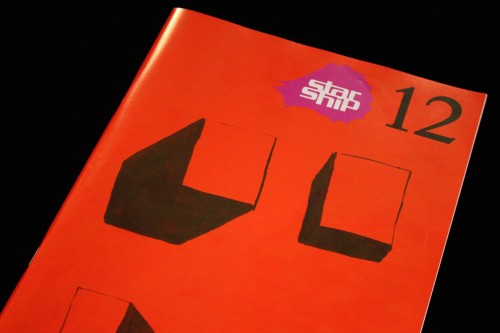
Out now: Star Ship #12

Star Ship is an art magazine based in Berlin. The articles are written in either English or German, depending entirely on the language that the writer wants to use: this kind of unconventionally laid-back editorial approach is very much part of the anarchic spirit of the publication.

In terms of its printed format, holding the magazine with your eyes closed you’d think it was a glossy, long-form publication like the New Yorker or the New Statesman. But opening your eyes and peering at each page, Star Ship appears more like a black and white patchwork of a zine. The contents page (above) is a good example of the scrap-book aesthetic, and the sparse amount of information in it is an example of how its is a magazine that doesn’t give things away easily. The page only features the name of the writer or the artist featured: it’s left to the reader to find out more. A second contents page at the back of the magazine, which is accompanied by a giant foot, (below) is similarly unconventional – Star Ship stamps out magazine traditions, and has a decisive air of mystery.

Editors Nikola Dietrich, Martin Ebner, Ariane Müller and Henrik Olesen also give artists free range, allowing them to take over the design of pages entirely. In their editor’s letter, the enigmatic quartet write: ‘

An interview with avant-garde filmmaker Morgan Fisher is also dense and thoughtful, reverting to more traditional elements of magazine layout while breaking conventions in its lack of sub-heading, pull-quotes or introduction (above). Star Ship does not guide you; you guide yourself, so that your reading experience is all the more immersive.

Cartoons similarly break the status-quo of magazine comics. The nonsensical and emotive, scratchy illustrations found dotted beneath essays are more like poems than cartoons (above).
With writers like the philosophical Chris Kraus and Egyptian short-story writer Haytham El-Wardany contributing to the pages, Star Ship boasts an exciting and provocative list of voices as well as visuals. It’s a publication that is almost like a dream of what would happen if great contemporary thinkers took over a mainstream, glossy magazine, and were given free range to do whatever they liked.
Review by Madeleine Morley




